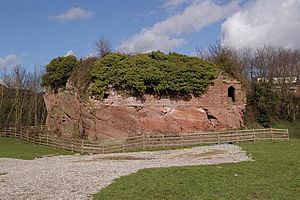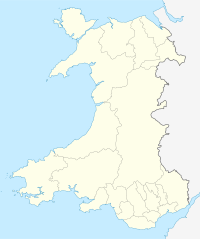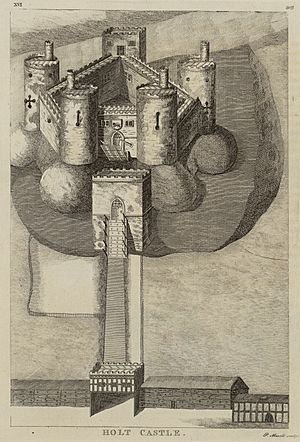Holt Castle facts for kids
Quick facts for kids Holt Castle |
|
|---|---|
| Castell Holt | |
| Part of the County Borough of Wrexham | |
| Holt, Wales | |

Holt Castle (pre-renovation)
|
|
| Coordinates | 53°04′41″N 2°52′49″W / 53.077919°N 2.880256°W |
| Type | Pentagonal enclosure castle |
| Height | Up to 10 metres (33 ft) |
| Site information | |
| Open to the public |
Yes |
| Condition | Complete ruin. Nothing remains of the castle except a few examples of masonry. |
| Site history | |
| Built | c. 1282–1311 |
| Built by | John de Warrene |
| Materials | Sandstone |
| Demolished | 1675–1683 |
| Battles/wars | Attacked during the uprising of Owain Glyndŵr |
| Events | Welsh Wars |
Holt Castle (Welsh: Castell Holt) was a medieval castle in the town of Holt, Wrexham County Borough, Wales. It was built in the 13th century during the Welsh Wars, a time when England and Wales often fought. The castle stood right on the border between Wales and England, next to the River Dee.
In the Middle Ages, this castle had five towers. It was sometimes called Castrum Leonis or Castle Lyons. This was because a lion symbol was carved into the stone above its main gate. By the 17th century, most of the castle's stone was removed. Today, only the base of its sandstone foundation is left.
Contents
Building a Stronghold: Holt Castle's Design
Holt Castle was built between 1277 and 1311. It was made from local sandstone. The castle stood on a 12-metre (39 ft) high rocky area, like a natural platform. Its shape was like a pentagon, which is a five-sided shape. There were strong towers at each of its five corners.
The castle had a sloped path leading up to its main entrance. It also featured a strong gatehouse, an inner courtyard, and back gates. Thick outer walls, called curtain walls, protected the castle. A moat filled with water from the River Dee surrounded the castle. This made it harder for enemies to attack.
The towers of Holt Castle were built right against the rock face outside the main walls. This design was similar to other castles built around the same time, like Ruthin and Conwy.
Holt Castle's Story: From Kings to Ruins
Holt Castle's construction began with King Edward I of England. He started building it on a sandstone base near the River Dee. This was soon after his army entered North Wales in 1277. In 1282, King Edward gave the land around Holt to a loyal lord named John de Warrene. John de Warrene was also given the job of finishing the castle. By 1311, the castle was complete. A new town was also planned next to it for English settlers.
About a hundred years later, in 1400, Welsh forces attacked the town. This happened during the uprising led by Owain Glyndŵr. The town was burned down, but the castle itself was not captured.
By the 16th century, Holt Castle was not used much and had started to fall apart. An English map maker named John Norden visited the castle. He wrote that it was "nowe in great decay," meaning it was in bad shape.
Holt Castle During the English Civil War
During most of the First English Civil War, soldiers loyal to the King (called Royalists) held Holt Castle. In 1643, soldiers loyal to Parliament (called Parliamentarians) captured it. However, the Royalists took it back in the spring of 1644. After the Parliamentarian soldiers surrendered, some of them were killed. Their bodies were thrown into the moat.
In January 1647, Holt Castle faced a long siege that lasted nine months. The Royalist leader, Sir Richard Lloyd, finally surrendered Holt to Thomas Mytton. Mytton was the commander of the Parliamentarian forces attacking the castle. After Holt surrendered, Harlech Castle was the only place in Wales still held by the Royalists. It fell to Mytton in March of that year.
After the surrender, Colonel Roger Pope became the Parliamentarian governor of Holt. Later that year, Parliament ordered Holt Castle to be destroyed. This was a common practice to prevent castles from being used again in future wars.
Between 1675 and 1683, much of the castle's stone was taken away. A man named Sir Thomas Grosvenor, 3rd Baronet used barges to move the stones down the river. He used them to rebuild his home, Eaton Hall, after the war.
By the 18th century, very little of Holt Castle remained. Only part of a tower and a rectangular building were left.
What Remains of Holt Castle Today?
Today, the main part of Holt Castle that is left is its sandstone base. You can still see a few stone features. These include the postern gate (a back gate) and a buttress (a support structure). The foundations of the outer gate's square tower are also visible.
From 2011 to 2015, a lot of work was done to restore the site. Workers removed plants, built steps, and repaired the remaining stone. Several archaeological studies were also carried out to learn more about the castle's past.
Images for kids
See also
 In Spanish: Castillo Holt para niños
In Spanish: Castillo Holt para niños





